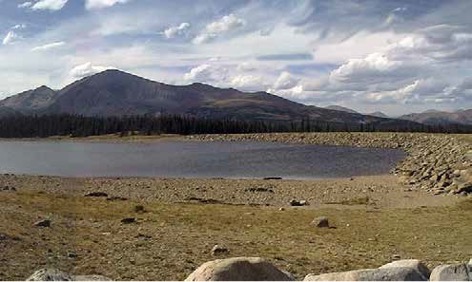“Lakespert” – Time for the Annual Snow Dance
Steve Lundt, CLM
Growing up in the Pacific Northwest, I would periodically perform my snow dance in January to help support my ski habit. Little did I know I was also helping the water supply system throughout the Cascades and Rocky Mountains. Today, I still do my snow dance in January but for different reasons – to make sure our Colorado reservoirs fill in the spring.
Many of our lakes and reservoirs are dependent on wintertime snowpack (Figure 1). Throughout the West, the Natural Resources Conservation Service (NRCS) closely monitors and reports snowpack or Snow Water Equivalent (SWE). These statewide monthly reports, forecasts, and interactive maps help water managers make critical decisions throughout the water year (typically November 1st to October 31st). Here is a great website to bookmark: nrcs.usda.gov/programs-initiatives/sswsf-snow-survey-and-water-supply-forecasting-program. Monthly snow surveys cover Alaska, Arizona, California, Colorado, Idaho, Montana, Nevada, New Mexico, Oregon, Utah, Washington, and Wyoming.
Higher elevation and wintertime moisture is the real combo that determines lake volumes in the western half of North America. From the Canadian Rockies to the Sierra Madre range in Mexico, these mountain ranges are natural reservoirs that store the winter fluff so that we can farm, recreate, and stay hydrated during the rest of the year. Elevation has not changed but climate has, so let the dancing begin.
Besides the obvious impact from less snowpack (winter droughts), changes in climate that also impact reservoir and lake volumes include faster and earlier warmups, dusty winds, overall warmer air temperatures, and drier snow. Thus, the need for enhancements to my January snow dance like throwing ice cubes in the toilet, putting a spoon under a pillow, or wearing PJs inside out and backwards (look them up).
It is no longer just about Jack Frost and how much snow we get each winter. It is about timing, overall weather patterns, ocean currents, polar vortexes, dust storms from dried up lakebeds, and how humans manage where water goes. The topic of snowpack, as with everything else, has become complicated. We now need to know moisture, density, albedo effect, wind patterns, and use complex models to help predict when it will all melt. For example, here in Colorado, April is the most critical month for the NRCS snow surveys. The median SWE peak for the state is April 7th. This is when all reservoir owners, managers, and water providers closely study the snow surveys across the “Headwaters State” to predict just how full or shallow the reservoirs will get. This also impacts several major river basins including the Colorado, Arkansas, Rio Grande, and Mississippi rivers. Maybe I need to move my snow dance to March.
For the start of 2024, Colorado’s statewide snowpack is 69 percent of median. That is a SWE of only 4.5 inches of moisture stored in the Colorado Rockies. There is still plenty of time until April but that sure puts a lot of pressure on my dancing skills.
 Steve Lundt, Certified Lake Manager, has monitored and worked to improve water quality at Barr Lake (Denver, Colorado) for the past 19 years. Steve is active with the Colorado Lake & Reservoir Management Association and is a past Region 8 director for NALMS and an active member since 1998.
Steve Lundt, Certified Lake Manager, has monitored and worked to improve water quality at Barr Lake (Denver, Colorado) for the past 19 years. Steve is active with the Colorado Lake & Reservoir Management Association and is a past Region 8 director for NALMS and an active member since 1998.


